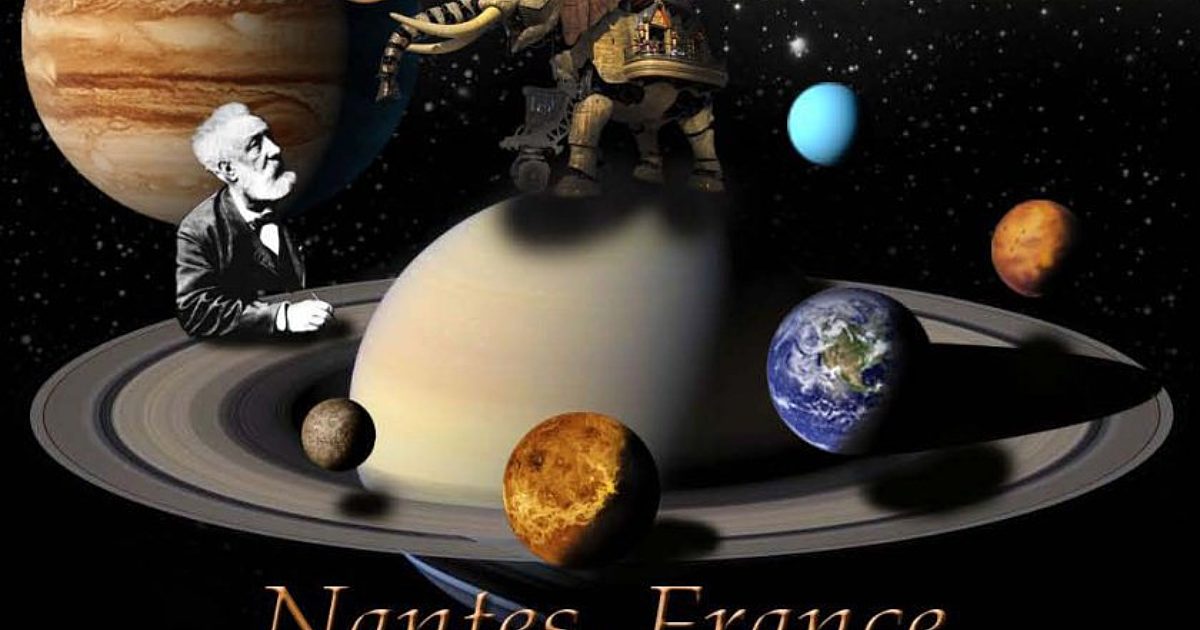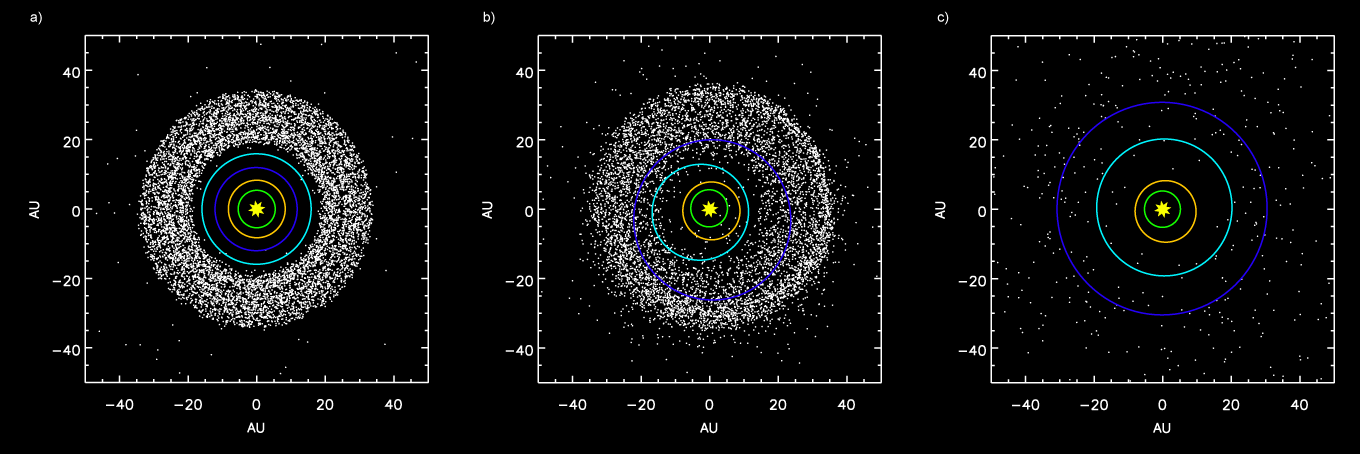And then I wrote… as I mentioned last week, back in 2011 I had started to write a column for the Tor.com site but after a few weeks the press of other matters caused me to abandon the project. I said before that I had had three columns, but actually there were only two that were finished and published. A shame that I didn’t have time to do more, since it’s a great site and I was proud to be a part of it. It’s because this article was originally written for an audience of Science Fiction Fans that I used the comparison of our meeting with the annual world gathering of SF Fandom, the Worldcon.
This week’s entry is particularly appropriate now, since as it happens the annual meeting of the American Astronomical Society’s Division for Planetary Sciences (or “The DPS” as we call it) starts – online, of course, this year – on Monday. The column that follows describes what I saw at the DPS meeting nine years ago, which was held jointly with the European Planetary Science Conference. They join forces this way every four or five years; last year was one such year, and the meeting was held in Switzerland.
 This past week the largest gathering of planetary astronomers ever, the joint EPSC-DPS meeting, was held in Nantes, France. It was the Worldcon of Planetary Astronomy.
This past week the largest gathering of planetary astronomers ever, the joint EPSC-DPS meeting, was held in Nantes, France. It was the Worldcon of Planetary Astronomy.
Nantes is of course famous as the home of Jules Verne. It is also the location of the incredible Gallery of the Machines, a must-see for any steampunk fan. (The meeting banquet began at the museum, with the large mechanical elephant in a rare nighttime walk leading the way.)
[embedyt] https://www.youtube.com/watch?v=MrTnYOWi1RI[/embedyt]
News from the meeting is not something I can give in a balanced way; I mostly attended the sessions that were important to my own field of meteorites and small bodies. Instead, consult the wonderful blogs and tweets from Emily Lakdawalla at the Planetary Society. (One bit of news: that year, 2011, she won the DPS’s annual Jonathan Eberhart prize for planetary science journalism. )
Instead, I want to talk about one of the most exciting new ideas of the past decade about how planetary systems form and evolve, and how the development of that idea reflects how our field itself has evolved over the last thirty years.
[In order to read the rest of this post, you have to be a paid-up member of Sacred Space, and logged in as such!]
Back in the 1970s, when I was a grad student, Europe was still not completely recovered from its economic and psychological devastation of World War II, even though 25 years had passed. Sending probes into space was something only the superpowers, the Russians and Americans, did. (There were one-shot exceptions from Britain and Italy; the cancellation of those programs, in spite of their successes, rather proves my point). Planetary science was a new-fangled luxury.
Thus in those days there were only two kinds of European planetary scientists: the elderly, mostly cranks who were completely out of touch with anything that had been discovered since 1925; and brilliant young astronomers, who mostly were working in the US. (One of those young Europeans, Mike Drake, was my first thesis advisor at Arizona in 1975; he wasn’t even yet 30 years old when he took me on. Sadly, he has just died, much too young, this past month [in 2011].)
This all changed with the organization of ESA, the European Space Agency, which really started to take off (literally!) in the 1990s. That was also about the time that (as was shown in a nice presentation at the DPS members session during this meeting) the demographics of American planetary scientists changed. Before the 90’s, the vast majority of American planetary scientists were under the age of 35 — and male. This is no longer true — that large post-Apollo cohort (like me) have gotten older (like me). In the process, the field has gotten much bigger; so while there are certainly more grad students today (about half of them women), their overall impact on the field is not proportionately as large. Meanwhile, there are now an enormous number of young scientists in Europe who are mostly unknown to their American counterparts. (Hence this joint meeting.)
This is reflected in what is certainly the most exciting development (outside of what we’re learning from spacecraft missions) in the field today. A group of celestial mechanics modelers have put together detailed computer programs (before the current generation of fast processors, you’d have needed a Cray) to calculate how all the planets’ orbits interacted with each other, and with smaller bodies, during the first half-billion years of the solar system.
 Simulation showing the outer planets and the Kuiper belt: a) Before Jupiter–Saturn 2:1 resonance. b) Scattering of Kuiper belt objects into the Solar System after the orbital shift of Neptune. c) After ejection of Kuiper belt bodies by Jupiter. Planets shown: Jupiter (green circle), Saturn (orange circle), Uranus (light blue circle), and Neptune (dark blue circle). Simulation created using data from the Nice Model. (Source: Wikipedia Commons)
Simulation showing the outer planets and the Kuiper belt: a) Before Jupiter–Saturn 2:1 resonance. b) Scattering of Kuiper belt objects into the Solar System after the orbital shift of Neptune. c) After ejection of Kuiper belt bodies by Jupiter. Planets shown: Jupiter (green circle), Saturn (orange circle), Uranus (light blue circle), and Neptune (dark blue circle). Simulation created using data from the Nice Model. (Source: Wikipedia Commons)Giant planets — especially Jupiter — were busy ejecting smaller bodies orbiting in resonance with those planets. As that mass got ejected, the orbits of the giant planets would have to have shifted, to conserve angular momentum. As the location of the giant planets drifted, the location of their resonances also shifted. Thus material that didn’t used to be liable to ejection, suddenly got ejected; and so the migration of these giant planets continued. Every now and then, two giant planets — most notably Jupiter and Saturn — would find themselves in a mutual resonance, causing one of them (Saturn) to pump up its eccentricity until it started perturbing planets like Uranus and Neptune into much more distant orbits. And maybe, in the process, one or two other ice giants that we never knew we had in our solar system were completely ejected from our system.
This whole scenario is justified by a number of different phenomenon that we used to have a hard time understanding. It explains the formation of Neptune and Uranus, which theorists could never explain before since early solar system material in the region where they are now would have been too spread out to have ever gathered into planets over the age of the solar system. It explains the origin and the odd orbits of the Oort cloud of comets (it’s the stuff that Jupiter ejected). It explains the structure of the Kuiper belt of comets. It explains the origin of the heavy bombardment of the inner solar system that appears to have occurred about 500 million years after the planets were formed. And — perhaps most importantly — a process of giant planet migration like this can explain all the “hot Jupiters” that we are now discovering in orbit around other stars.
New developments in this model, presented at [the 2011] meeting, included how it explains the loss of most of the stuff that should have made up Mars, not to mention the planet that ought to have been made in what is now in the asteroid belt, and the distribution of what little stuff remains there.
It’s a nice model; and in fact, it is called the Nice model, since it was developed in Nice, France, at the Observatoire de la Cote d’Azur. The people involved are an international group that include young scientists (younger than me, at least) from Italy, France, Portugal, Germany, Brazil (planetary science has become quite the thing now in South America) and the US. Indeed, a postdoctoral fellowship (or a sabbatical year) in Nice is a necessity nowadays for anyone who wants to understand the evolution of the structure of our solar system.
Incidentally, this whole new understanding of how giant planets migrate and drag the smaller bodies around in their wake is one of the reasons why the dynamicists are so insistent that Pluto is not a “planet”. It’s not big enough to drag things as it moves; rather, it was itself dragged into its current orbit as Neptune migrated. The whole Pluto controversy in 2006 happened to occur just as the first papers of the Nice model were being published.
The DPS is the Division for Planetary Sciences of the American Astronomical Society, a group of about a thousand professional planetary scientists (20% non-US, in spite of the name); we have been holding planetary science meetings since the early 1970s. (Only one member, Clark Chapman, has attended every meeting.) The EPSC is the European Planetary Science Conference, not an organization but an annual meeting, which is funded by the European Union. It serves as the European version of the annual DPS meeting. Both groups meet in the fall, so it only made sense to try a joint meeting; this one was a rousing success. There were more than 1400 attendees, five parallel sessions, overflowing rooms at the Nantes Congress Centre.
